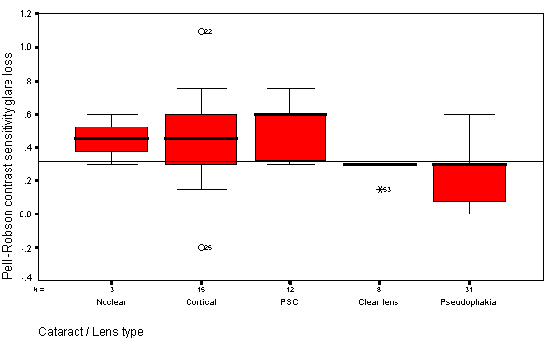Assessment of visual function in cataract patients
with a mean visual acuity of 6/9
Three groups of cataract patients, classified by cataract morphology and matched for mean visual acuity of 6/9, underwent measurement of an array of other visual functions. These included low contrast visual acuity with and without glare and contrast. sensitivity with and without glare. This provided a more global appreciation of the impact of cataract on vision. In particular, the variation of the pattern of visual function with cataract morphology. This information is valuable in the clinical setting, to appreciate the visual impairment suffered by the cataract patient that is not evident from visual acuity testing alone. This may aid in decision making for surgery. Information on with expected patterns of visual function for cataract types would also be valuable to help unravel the contribution of cataract to visual loss in cases ocular comorbidity.

Figure 2. Pelli-Robson contrast sensitivity glare loss by lens type. the box represents the interquartile range, or the middle half of the ranked data. The reference line represents the 95% CI, which is the level required to exclude all clear lens cases and identify the cases with an abnormal loss of glare on the Pelli-Robson chart. The cortical and PSC groups are significantly worse than the clear lens group (P < 0.05).
Australian and New Zealand Journal of Ophthalmology 1996; 24: S5-S9
Konrad Pesudovs BScOptom FAAO
Douglas J Coster FRACO
Department of Ophthalmology, Flinders Medical Centre, Flinders University of South Australia, Bedford Park, South Australia, Australia
![]()
Index of Papers
[ Welcome ][ Publications ]